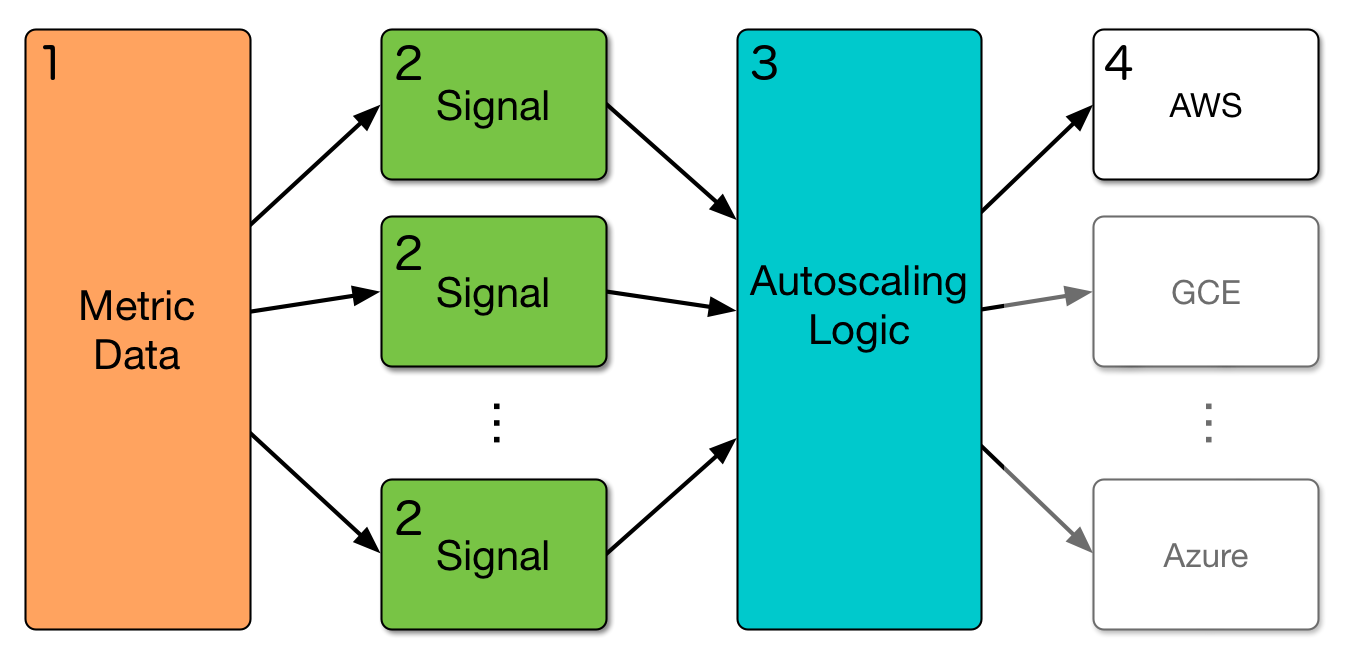Ecosyste.ms: Awesome
An open API service indexing awesome lists of open source software.
https://github.com/Yelp/clusterman
Cluster Autoscaler for Kubernetes and Mesos
https://github.com/Yelp/clusterman
Last synced: 2 months ago
JSON representation
Cluster Autoscaler for Kubernetes and Mesos
- Host: GitHub
- URL: https://github.com/Yelp/clusterman
- Owner: Yelp
- License: apache-2.0
- Created: 2019-11-14T23:49:29.000Z (over 4 years ago)
- Default Branch: master
- Last Pushed: 2024-01-04T15:17:42.000Z (5 months ago)
- Last Synced: 2024-01-20T21:50:37.023Z (5 months ago)
- Language: Python
- Homepage:
- Size: 167 MB
- Stars: 296
- Watchers: 13
- Forks: 20
- Open Issues: 31
-
Metadata Files:
- Readme: README.md
- License: LICENSE
- Code of conduct: code-of-conduct.md
Lists
- awesome-cloud-native - Clusterman - Cluster Autoscaler for Kubernetes and Mesos. (Cluster)
README
[](https://github.com/Yelp/clusterman/actions/workflows/ci.yaml)
[](https://clusterman.readthedocs.io/en/latest/?badge=latest)
# Clusterman - Autoscale and Manage your compute clusters

Clusterman (the Cluster Manager) is an autoscaling engine for Mesos
and Kubernetes clusters. It looks at metrics and can launch or terminate
compute to meet the needs of your workloads, similarly to the official
[Kubernetes Cluster Autoscaler](https://github.com/kubernetes/autoscaler/tree/master/cluster-autoscaler)
It provides the following set of features:
* Customizable metrics: All metrics for Clusterman are stored in an
external datastore, and are automatically loaded into the signals
that need them
* Pluggable autoscaling signals: Your team knows how the application
you're running should scale in response to metrics, so your team
should own the signal that tells Clusterman what to do
* Full-featured simulation environment: Want to know how the autoscaler
is going to respond to production traffic before you deploy changes?
The Clusterman simulation environment lets you do this. You can also
simulate future traffic so that you can predict usage or cost increase
before they happen.
For more information, see the [Clusterman documentation](https://clusterman.readthedocs.io/en/latest/)
## Getting Started
You can try out Clusterman in a local development environment against
a Dockerized Mesos cluster by running the following commands:
make example
clusterman status --cluster local-dev -v
All of the Clusterman CLI commands should work in the above environment.
You can see examples of the Clusterman services by running
make itest-external
## Components

Clusterman is made up of the following components:
* Metrics Data Store: All relevant data used by scaling signals is written
to a single data store for a single source of truth about historical
cluster state. At Yelp, we use AWS DynamoDB for this datastore. Metrics are
written to the datastore via a separate metrics library.
* Pluggable Signals: _Metrics_ (from the data store) are consumed by _signals_
(small bits of code that are used to produce resource requests. Signals
run in separate processes configured by [supervisord](http://supervisord.org),
and use Unix sockets to communicate.
* Core Autoscaler: The autoscaler logic consumes resource requests from the
signals and combines them to determine how many resources to request from or
release back to the cloud provider.
* Resource Groups and Pools: Each autoscaler instance manages exactly one
"pool", that is, a logical grouping of machines in a cluster. Pools consist
of "resource groups", such as a Spot Fleet Request (SFR) or AutoScaling Group
(ASG) from AWS EC2.
* Configuration: Clusterman stores global configuration values in a file called
`clusterman.yaml`, and per-pool configuration in `clusterman-clusters//.(mesos|kubernetes)`.
These config files tell the Clusterman services when and how to run, and they
serve as the glue to hook up an autoscaler with its signals. Configure the
path to `clusterman.yaml` with the `--env-config-path` flag, and the path to
`clusterman-clusters` with `--cluster-config-directory`.
* An Autoscaling Simulation Environment: Clusterman comes with a complete
simulation environment for running tests with your signals on historical data
before they are deployed. This environment can produce information about the
cost of your cluster, as well as whether it is over- or under-provisioned.
Clusterman has two main ways of interacting with the clusters it manages. The
Clusterman CLI provides a set of command-line tools for viewing and managing
the state of the cluster; type `clusterman --help` to see a list of possible
subcommands. See the Clusterman documentation for more details.
The Clusterman service runs as a set of three long-running processes; the first
process collects data about spot instance pricing from AWS (not required if you
aren't using AWS, spot instances, or the Clusterman simulator); the second
process queries each of the pools in a cluster to collect metadata and system
metrics about the pool; and the third process is responsible for actually
autoscaling each of the pools.
## Integrating Clusterman
At Yelp, we use [PaaSTA](https://github.com/Yelp/PaaSTA), our
platform-as-a-service, to manage Clusterman. If you use PaaSTA, setting up
Clusterman should be relatively straightforward. Otherwise you will need
to provide additional tooling to deploy the Clusterman code or Docker image
to your environment.
If you'd like to use Clusterman in your environment, you will need the
following components set up:
* A metrics datastore with the appropriate tables. See `examples/terraform/clusterman.tf`
for a Terraform representation of the schema in DynamoDB.
* A `clusterman_metrics` library that can communicate with your chosen metrics
datastore. There is a reference copy of the metrics library in `examples/clusterman_metrics`
that is capable of communicating with AWS DynamoDB.
* Code to run the autoscaler service. At Yelp, we use an internal
batch library called `yelp_batch` for this task; however, the same goal
can be achieved by simply running the code in a never-terminating while
loop. See the sample code in `examples/batch` for a place to start.
* Configuration files. Clusterman uses one "master" configuration file as well
as a configuration file per pool that it autoscales. You can see examples of
these config files in `acceptance/srv-configs`, and the config file schema in
`examples/schemas`.
To build a Debian package for the Clusterman CLI, run `make package`. To build
an example Docker image which can run the Clusterman batch code, run `make cook-image-external`
Clusterman uses EC2 tags in order to find the resource groups that it manages.
To configure a resource group so that Clusterman can find it, you need to add a
tag like the following to your ASG or SFR:
tag-name: "{\"paasta_cluster\": \"cluster-name\", \"pool\": \"pool-name\"}"
You can specify the value of `tag-name` in your configuration file for the pool:
resource_groups:
- (sfr|asg):
tag: tag-name
## Design Goals
Clusterman is designed to support a wide range of cluster autoscaling needs at
Yelp. We run many different types of workloads (long-running services, batch
jobs, machine learning tasks, databases, etc.) on top of Kubernetes and Mesos,
and each of these workloads has a different set of scaling requirements.
Clusterman is designed to be a unified system that can accomodate each of these
workloads. To that end, Clusterman's design goals are:
* A modular design that separates cloud API calls from signal evaluation and
the core autoscaling loop
* Unified autoscaling logic for a multi-tenant cluster
* Client-owned scaling signals for requesting resources
* A command-line interface for managing and interacting with clusters
* A simulation environment for performing cost and behaviour analysis
## Licence
Clusterman is licensed under the Apache License, Version 2.0: http://www.apache.org/licenses/LICENSE-2.0
## Contributing
Everyone is encouraged to contribute to Clusterman by forking the
[Github repository](http://github.com/Yelp/clusterman) and making a pull request or
opening an issue. Please read our [Code of Conduct](https://github.com/Yelp/clusterman/code-of-conduct.md).
### Instructions for Yelp developers
1) Make your changes, push a branch to GitHub, and create a pull request
2) Once your PR is approved, merge your changes to master
A Jenkins pipeline polls GitHub and brings any changes into our internal version. Jenkins will then build and deploy Clusterman as normal.